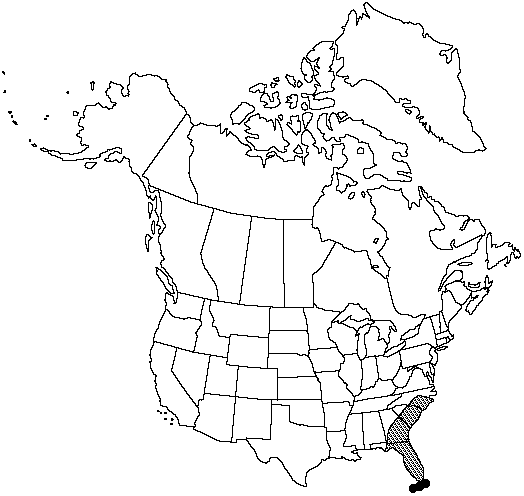Selaginella acanthonota
Torreya 2: 172. 1902.
Plants terrestrial, less often on rock, forming close clumps. Stems radially symmetric, underground (rhizomatous) and aerial, not readily fragmenting, irregularly forked; rhizomatous and aerial stems often with 1 branch arrested, budlike, tips straight; rhizomatous stems with budlike branches, these sometimes inconspicuous; aerial stems erect or ascending, lateral branches conspicuously determinate. Rhizophores borne on upperside of stems, restricted to rhizomatous stems or lowermost base of aerial stems (seldom on distal 2/3, if so, short), mostly aerial, 0.25–0.43 mm diam. Leaves monomorphic, in pseudowhorls of 4 or 5, tightly appressed, ascending, green, narrowly triangular-lanceolate or narrowly lanceolate, 2–3.25 × 0.4–0.6 (–0.7) mm; abaxial ridges present; base rounded to cuneate, slightly decurrent to adnate, pubescent; margins ciliate, cilia transparent, spreading at base, dentiform, ascending toward apex, 0.02–0.1 mm; apex plane, attenuate or seldom slightly keeled; bristle white or whitish to transparent, sometimes with brownish to reddish band at base marking breaking point (in old leaves), straight, puberulent, (0.35–) 0.5–1.4 mm. Strobili solitary, (0.5–) 1–3 (–3.5) cm; sporophylls ovatelanceolate to lanceolate, abaxial ridges not prominent, base pubescent, margins ciliate, apex bristled.
Habitat: Pine barrens, sand pine-oak scrubs, dry sandy hill or dunes, open white sandy soil, white sand, or sandstone rock
Elevation: 0 m
Distribution

Fla., Ga., N.C., S.C.
Discussion
Selaginella acanthonota is a member of the S. arenicola complex, a taxonomically difficult group. Specimens of S. acanthonota from the northern part of its range (e.g., North Carolina, South Carolina, and Georgia) tend to have rather prostrate underground (rhizomatous) stems, with ascending to erect, short aerial stems. Those from Florida have rather ascending underground (rhizomatous) stems and more slender aerial stems. Selaginella acanthonota, in addition to features given in the description, is characterized by having hairs running lengthwise along or at least to the proximal half of the ridges bordering the abaxial groove of the leaves and sporophylls, and, usually, puberulent leaves and sporophyll apices. The hairs on the ridges sometimes break off easily or are somewhat enclosed within the abaxial groove (when the ridges close as a response to dryness), but they can be seen under a microscope. More systematic studies are needed within S. acanthonota and the entire S. arenicola complex.
Selected References
None.